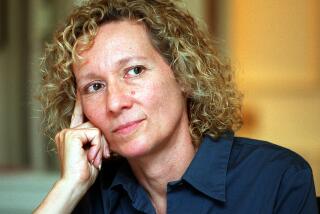Miriam Wosk dies at 63; illustrator and mixed-media artist
Miriam Wosk, a commercial illustrator who designed the first cover of Ms. magazine and then transformed herself into a fine artist who created surreal, vibrant, mixed-media pieces, has died. She was 63.
Wosk, who was diagnosed with cancer five years ago, died Friday at her Santa Monica home, said her son, Adam Gunther.
At 19, she moved to New York City from her native Vancouver, Canada, to study illustration at the Fashion Institute of Technology and eventually freelanced as an artist who specialized in women’s subjects.
When Ms. magazine debuted in late 1971 as an insert inside New York magazine, Wosk designed the cover that depicted a pregnant, eight-armed goddess juggling the demands of work, marriage and motherhood.
“You’d paint something on Monday and by Friday a million people would see it,” she told The Times in 2004. “It was very gratifying.”
By the late 1970s, Wosk was trying to transition to fine art but publications kept imploring her to take assignments. To escape, she relocated to Los Angeles and found the West Coast helped her reinvent herself.
“My paintings reflected the light, the joyous, uplifting attitude of being in California,” she said in 2006 in Venice magazine. “I started putting jewels in the work right away. Brightly colored, highly patterned, more exuberant, that’s how the atmosphere made me feel.”
Working in paint, pastel and collage on paper, Wosk often began with an anatomical image that she smothered “in veil upon veil of floral ornament and pattern, creating a sort of gothic, hyper-decorative Surrealism that is as invigorating for the imagination as it is for the eye,” according to a 2006 Times review of the show “Sequins and Skeletons” at the now-defunct Billy Shire Fine Arts Gallery in Culver City.
“Her art was definitely a major deal and her use of materials broke a lot of boundaries,” Shire told The Times. “She kind of put forth in her work that art could be beautiful as well as meaningful.”
Through the laborious collages that she wove together from unexpected materials — anatomical diagrams, vintage wallpaper, postcards, crystals — Wosk explored the interconnectedness of nature.
There also was a spiritual undertone to her work as she grappled with the disease that eventually took her life, her son said.
For his documentary short “Language of the Soul: The Art of Miriam Wosk,” Terry Sanders said he filmed his “generous and warm” neighbor between 2004 and 2006 to chronicle her “fascinating” multi-project approach.
“She had these incredible fabrics and so forth that she picked up over the years, all stored beautifully in drawers and in her head,” he said. “She drew on all these materials. Her mind and her passion were very impressive.”
Born Aug. 17, 1947, she was the eldest of four children of Morris Wosk, a prominent Vancouver real estate developer, and his wife, Dena, a concert violinist.
Miriam Wosk was in the fourth grade when she knew that she wanted to be an artist. After she moved to New York, she became a fashion illustrator for Vogue and other publications.
Except for an occasional workshop, she was largely self-taught as a painter. The “greatest teacher was doing the work,” she said in the documentary.
Over the last 30 years, her pieces have been in more than 100 exhibits in California, New York and elsewhere.
She bought a nondescript, four-story apartment building in Beverly Hills and hired architect Frank Gehry in 1981 to redesign the penthouse in which she planned to live.
Gehry’s respect for Wosk’s “fantastic artistic abilities” led to a close collaboration, The Times reported in 1982. She drew sketches for him to work from and designed tile work, stair rails and stained glass.
Married and divorced by 1998, Wosk had a son and wanted to live in a house. She bought a 1926 Mediterranean villa in Santa Monica, and with architect Steven Ehrlich set out to create an environment inspired by the playfulness of Spanish architect Antonio Gaudi.
The extensive remodel included adding a large studio open to the outdoors that drenched her colorful works with abundant natural light.
She had wanted a “clean, white shell in which to put my things,” which included abundant and bold fine art, mercury-glass candlesticks, vintage cookie jars, masks, silver sombreros and many other objects.
Her explanation for her penchant for collecting also applied to her art.
“I’m a visual glutton,” she told The Times in 2004. “More is more.”
In addition to her son, Wosk is survived by three brothers, Kenneth, Mordechai and Yosef, all of Vancouver.
More to Read
Start your day right
Sign up for Essential California for the L.A. Times biggest news, features and recommendations in your inbox six days a week.
You may occasionally receive promotional content from the Los Angeles Times.







